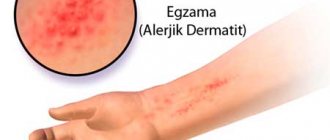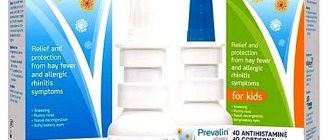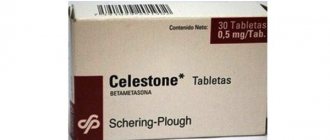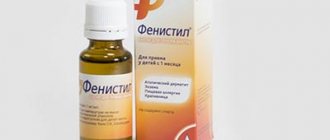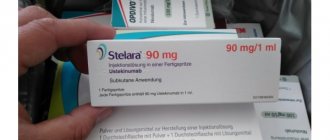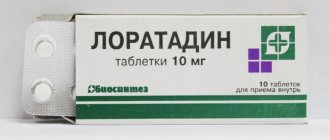| racemate mixture 1:1 | |
| Fexofenadine | |
| Chemical compound | |
| IUPAC | ( RS )-2-[4-[1-hydroxy-4-[4-(hydroxy-diphenyl-methyl)-1-piperidyl]butyl]phenyl]-2 -methylpropanoic acid |
| Gross formula | C₃₂H₃₉NO₄ |
| Molar mass | 501.656 |
| CAS | 83799-24-0 |
| PubChem | 3348 |
| DrugBank | 00950 |
| Classification | |
| ATX | R06A626 |
| Pharmacokinetics | |
| Bioavailable | Not installed yet |
| Plasma protein binding | 60-70 % |
| Metabolism | Liver (5% dose) |
| Half-life | 14.4 hours |
| Excretion | With stool (~80%) and urine (~11%) unchanged |
| Dosage forms | |
| pills | |
| Method of administration | |
| Oral | |
| Other names | |
| Allegra, Telfast | |
| Fexofenadine at Wikimedia Commons | |
This term has other meanings, see Allegra.
Fexofenadine
- an antihistamine, a metabolite of terfenadine, devoid of cardiotoxic properties. According to various criteria, it is classified as a second[1] or third generation[2] histamine H1 receptor blocker.
Story
The antihistamine terfenadine is completely metabolized to fexofenadine after oral administration. At the same time, fexofenadine does not have the cardiotoxic properties inherent in terfenadine. Work on the synthesis of fexofenadine instead of terfenadine was carried out in many laboratories [3]. It was made in the USA in 1993 by Sepracor (Massachusetts), after which the rights were sold to Hoechst Marion Roussel (now part of Sanofi-Aventis). The drug is one of the best-selling in the world, with the largest sales volume coming from the United States. Since the spring of 2011, it has been approved in the United States for over-the-counter release from pharmacies.
Fexofenadine
International name of the medicinal substance:
Fexofenadine The list of drugs containing the active substance Fexofenadine is given after the description.
Pharmacological action:
Antihistamine is a pharmacologically active metabolite of terfenadine.
Blocks H1-histamine receptors and stabilizes mast cell membranes, reduces the release of histamine and other biologically active substances from them. The antihistamine effect appears 1 hour after oral administration, reaches a maximum after 6 hours and continues for 24 hours. After 28 days of administration, no addiction was observed. In the dose range of 10-130 mg, a dose-dependent effect is observed. Pharmacokinetics:
After oral administration, it is quickly absorbed from the gastrointestinal tract, TCmax - 1-3 hours. The average Cmax after taking 180 mg is approximately 494 ng/ml, after taking 120 mg - 427 ng/ml. Bonding with plasma proteins is 60-70% (mainly with albumin and alpha1-glycoprotein). T1/2 after multiple doses is 14.4 hours. In patients with moderate (creatinine clearance 41-80 ml/min) and severe (11-40 ml/min) renal failure, T1/2 increases by 59 and 72%, respectively; in patients on hemodialysis, T1/2 increases by 31%. Subjects (5% of the dose) to partial extrahepatic metabolism. It is excreted predominantly (80%) with bile, 11% by the kidneys unchanged.
Indications:
Urticaria, allergic rhinitis, hay fever.
Contraindications:
Hypersensitivity, pregnancy, lactation, children (up to 6 years).
Side effects:
Headache, drowsiness, dizziness, dyspepsia, excessive fatigue.
Interaction:
When administered together with erythromycin or ketoconazole, the plasma concentration of fexofenadine increases 2-3 times, which is apparently associated with an increase in absorption in the gastrointestinal tract and a reduction in either bile excretion or gastrointestinal secretion (not accompanied by increased side effects) .
Taking Al3+ or Mg2+-containing antacids 15 minutes before taking fexofenadine leads to a decrease in the bioavailability of the latter (the time interval between their administration should be at least 2 hours). Does not interact with omeprazole, with drugs metabolized in the liver. Special instructions:
The effectiveness and safety of use in children under 6 years of age have not been studied.
It is possible to perform work that requires a high concentration of attention and speed of psychomotor reactions (with the exception of patients with non-standard reactions). Preparations containing the active ingredient Fexofenadine:
Allegra, Allerfex, Beksist-sanovel, Gifast, Dinox, Rapido, Telfadin, Telfast, Fexadin, Fexo, Fexofast, Fexofenadine hydrochloride, Fexofenadine-Akrikhin
The information provided in this section is intended for medical and pharmaceutical professionals and should not be used for self-medication. The information is provided for informational purposes only and cannot be considered official.
Notes
- Dicpinigaitis PV, Gayle YE.
Effect of the second-generation antihistamine, fexofenadine, on cough reflex sensitivity and pulmonary function. - 2003. - T. 56, issue. 5. - PMID 14651723. - Vena GA, Cassano N, Filieri M, Filotico R, D'Argento V, Coviello C.
Fexofenadine in chronic idiopathic urticaria: a clinical and immunohistochemical evaluation. - 2002. - T. 15, issue. 3. - PMID 12575922. - Daniel Lednicer.
The Organic Chemistry of Drug Synthesis. — New York: Wiley Interscience. - T. 6. - ISBN 0-471-24510-0. - Fexadine
"Fexofenadine": instructions for use
Outside of Russia, the medicine can be produced in the form of a suspension and tablets. therefore, its appointment is made taking into account these features. The medicine "Fexofenadine", the price of which is presented to your attention above, is used exclusively internally. Take the medication with clean water. It is contraindicated to dilute tablets or suspension in juices.
The dosage of the medicine for an adult is 120-180 milligrams. Children over twelve years of age are advised to use the same amount of active substance. Frequency of application – once a day. For children from 6 to 12 years old, 60 milligrams of the drug per day is usually prescribed, divided into two doses. For convenience, some fexofenadine-based drugs are available in a dosage of thirty milligrams. The duration of treatment is determined by the doctor in each situation separately.
Interaction
The substance has the ability to bind to magnesium or aluminum preparations in the gastrointestinal tract . As a result, its bioavailability is significantly reduced. In this regard, it is recommended to maintain a 2-hour interval between doses of this type of medicine.
Fexofenadine does not affect the functioning of drugs that undergo hepatic metabolism.
When taking the drug in combination with ketoconazole or erythromycin , its plasma concentration increases by 2-3 times. In this case, the drugs do not affect the QT .
The product can be combined with Omeprazole .
Reviews of Fexofenadine
Reviews of Fexofenadine drugs are good. Given the high effectiveness of the substance, unwanted side reactions rarely occur.
Some reviews about the drug Telfast:
- “... As soon as summer begins, I start taking Telfast tablets for allergies. I’ve tried many antihistamines, but I like this drug the most, it doesn’t cause drowsiness and helps well”;
- “... I am an allergy sufferer with 15 years of experience. As soon as summer begins, chamomile, wormwood, birch bloom - I feel very bad, my eyes are watery, my nose is stuffy, there is no disorder at all. I like these pills the most, you take one in the morning and you feel good all day, then you feel normal, no drowsiness, no headaches”;
- “...Telfast is used to treat urticaria. According to my observations, the medicine begins to act after a few days of use, most effectively when combined with other allergy medications. The drug is quite safe and of high quality, I have never observed any adverse reactions.”
What is the price. About the cost of the medicine
The cost of Fexofenadine depends primarily on the dosage of the active substance (120 and 180 mg) and the region of sales.
| Name | Dosage | Number of tablets | Cost (rubles) |
| Fexofenadine-Akrikhin | 180 mg | 10 | 288 |
| Fexofenadine-Akrikhin | 120 mg | 10 | 204-261 |
| Fexadine | 180 mg | 10 | 387-470 |
| Fexadine | 120 mg | 10 | 306-330 |
| Allegra | 120 mg | 10 | 457-507 |
| Allegra | 180 mg | 10 | 605 |
Contraindications
Fexofenadine, unlike other antihistamines, has a minimal list of side effects and contraindications. The latter include:
- individual intolerance to fexofenadine hydrochloride or additional components;
- lactase deficiency;
- lactose intolerance;
- the patient's age is up to twelve years.
Caution should be taken when prescribing Fexofenadine, even according to the instructions for elderly patients (no dose adjustment is required); the drug should be used only with the consent of a doctor and under his supervision. If there is a history of renal/liver failure, no dose adjustment is required, but medical supervision of therapy is necessary.
Interesting to know
Special instructions for the use of Fexofenadine during breastfeeding and pregnancy
Detailed studies have not been conducted to prove the safety of Fexofenadine for women during breastfeeding. In any case, the active substance of the drug penetrates the mother’s systemic bloodstream and therefore enters the produced breast milk.
Taking into account the fact that the drug has a long-term effect and the release of the active antihistamine occurs within 24 hours, you should either stop breastfeeding during the treatment period or choose another drug (approved during pregnancy and breastfeeding).
Side effects that are extremely rare:
- migraine;
- impaired coordination of movement;
- cardiopalmus;
- problems with urination;
- Quincke's edema;
- hepatitis;
- with long-term therapy – weight gain;
- difficulty moving limbs;
- sleep problems;
- conditions accompanied by memory loss, hallucinations;
- disturbances in the functioning of taste buds in the oral cavity;
- pre-fainting states.
Overdose symptoms
If the recommended dosage for use of Fexofenadine is exceeded, symptoms of overdose may occur, expressed in the form of dry mouth, dizziness, weakness, loss of consciousness and drowsiness.
To avoid intoxication of the body, you should perform a gastric lavage, drink a laxative drug and take activated charcoal or another absorbent.
Fexofenadine and its interactions with other drugs
With simultaneous use of Fexofenadine and Erythromycin according to the instructions, the concentration of the antihistamine increases at least twice. The same thing happens if you take Fexofenadine with Ketoconazole.
The drug is inert towards Omeprazole.
Treatment recommendations
If, due to the presence of chronic diseases, the patient requires constant use of antacids that contain magnesium or aluminum, an interval of at least two to three hours should be maintained between doses of Fexofenadine and antacids.
In some cases, patients treated with Fexofenadine may experience drowsiness and dizziness, therefore, during the treatment period, you should limit the operation of complex mechanisms and vehicles, as well as perform work that requires attentiveness and composure.
Drugs containing (Fexofenadine analogues)
Level 4 ATX code matches:
Dezal
Histaphene
Clarisens
Telfast
Erius
Claridol
Claritin
Loratadine
Fexofast
Peritol
Desloratadine
LauraHEXAL
Clarotadine
Rupafin
Ciel
Dramamine
Lordestin
Lomilan
Fenkarol
Kestin
Preparations containing Fexofenadine: Telfast, Allegra, Beksist-Sanovel, Dinox, Fexadin, Fexofenadine Hydrochloride, Gifast, Telfadin, Fexofast, Allerfex .
